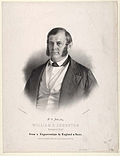Presidential candidates
After the most intense excitement had prevailed, the Convention agreed to a motion of Mr. Ely to proceed to an informal vote for nomination. Former Governor Johnston received 14 votes, but before the vote was closed he announced that he was not a candidate, whereupon several members changed their votes for other parties. The result of the informal ballot placed Fillmore in first place with 71 votes. Mr. Norris of Delaware withdrew the name of Senator Clayton and said his state was now united for Fillmore.
The vote for president was then proceeded with, the name of each member being called, each state being entitled to its vote in the Electoral College, the absentees, to be voted for proportionately by the votes cast; no state not represented to be entitled to vote. The unofficial first ballot saw Fillmore increase his strength to 114 votes. It was at this point that various delegates changed their votes to Fillmore. The official first ballot saw former President Millard Fillmore nominated for president with 179 votes out of the 242 votes cast.
Mr. Scraggs, the delegate from New York who had placed Law in nomination, moved that Fillmore be declared the unanimous choice of the Convention. The motion being put, it was carried by a tremendous shout of ayes.
Presidential Balloting / 3rd Day of Convention (February 25, 1856)
















